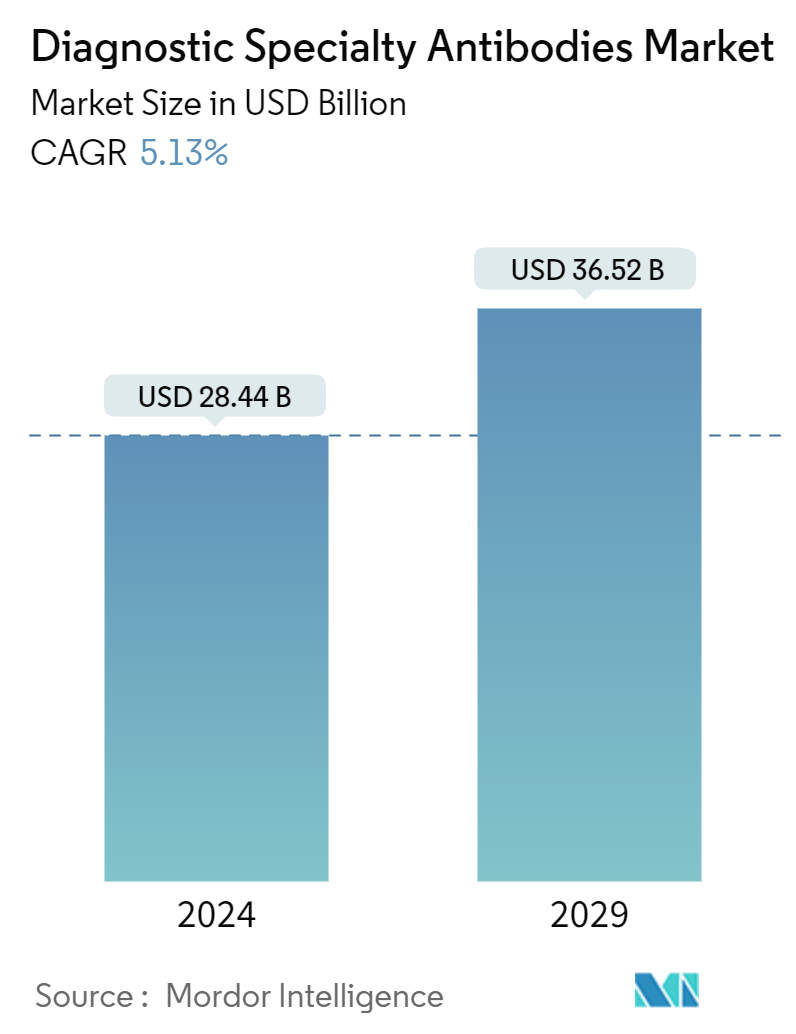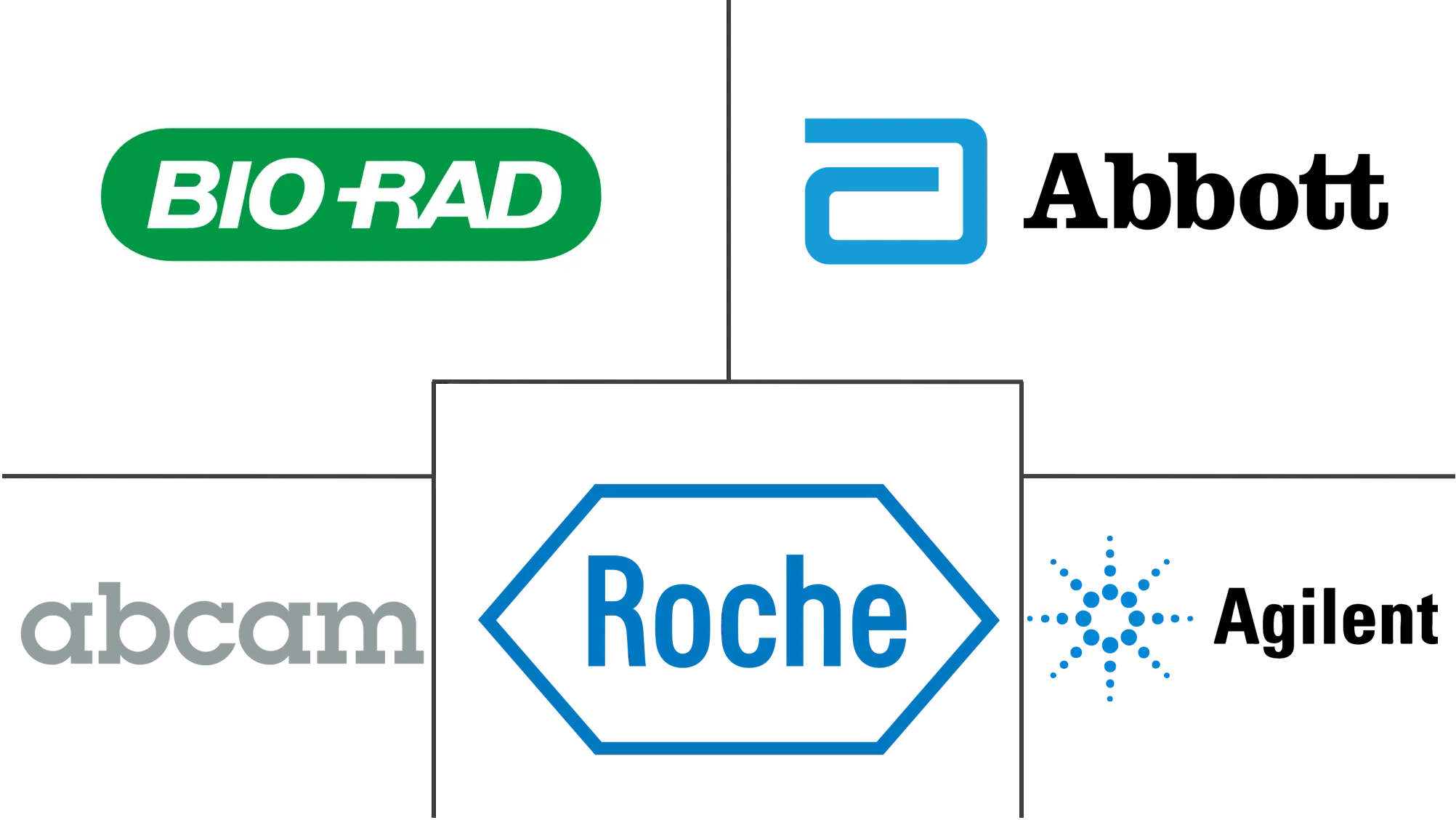Market Size of Diagnostic Specialty Antibodies Industry

| Study Period | 2019 - 2029 |
| Market Size (2024) | USD 28.44 Billion |
| Market Size (2029) | USD 36.52 Billion |
| CAGR (2024 - 2029) | 5.13 % |
| Fastest Growing Market | Asia Pacific |
| Largest Market | North America |
Major Players
*Disclaimer: Major Players sorted in no particular order |
Diagnostic Specialty Antibodies Market Analysis
The Diagnostic Specialty Antibodies Market size is estimated at USD 28.44 billion in 2024, and is expected to reach USD 36.52 billion by 2029, growing at a CAGR of 5.13% during the forecast period (2024-2029).
The COVID-19 pandemic has had a substantial impact on the diagnostic specialty antibodies market. The usage of diagnostic antibodies underwent a significant rise during the pandemic as these antibodies were adopted quickly for the detection of COVID-19 during the pandemic. For instance, according to an article published by PubMed Central in February 2021, the main-stream diagnostic methods used during the pandemic to detect the presence of SARS-CoV-2 virus in the laboratory include nucleic acid PCR tests and direct viral antigen tests for detecting active infections, and indirect human antibody tests specific to SARS-CoV-2 to detect prior exposure. Furthermore, according to FDA in February 2022, SARS-CoV-2 antibody tests can help identify people who may have been infected with the SARS-CoV-2 virus or have recovered from COVID-19. But the antibody tests cannot be used to detect active COVID-19 infection. Currently, the usage of antibodies for COVID-19 testing lowered drastically as other tests like PCR and antigen tests have become much more popular due to the confirmatory results that they provide. Thus, the COVID-19 outbreak affected the market's growth favorably in its preliminary phase; however, during the forecast period, the market is likely to go back to how it was during the pre-pandemic phase.
The advancements in DNA-based technologies and diagnostics are expected to boost market growth. In addition, the high number of patient pools undergoing diagnosis of HIV and the growing demand for specialty diagnostics around the world are projected to fuel the market. Furthermore, the increase in the prevalence of diseases such as infectious diseases, influenza, and cancer is expected to boost the diagnostic antibodies market.
For instance, according to an article published by BMC in January 2022, immunohistochemistry (IHC) using monoclonal and polyclonal antibodies is a very useful and popular diagnostic method for detecting pathogen antigens in fixed tissues, it complements the direct diagnosis of infectious diseases by PCR and culture on fresh tissues. The article also stated that the immunohistochemical technique is a rapid and efficient way of identifying HIV antigens in fixed surgical and autopsy specimens. The immunohistochemistry technique using an anti-p24 monoclonal antibody has proven to be very useful for detecting HIV in lymph node biopsies of patients with unexplained follicular hyperplasia.
In addition, new key developments and strategic activities by major players in the market are positively affecting the growth of the studied market. For example, according to an article published by MDPI in April 2021, monoclonal antibodies are an emerging tool for cancer diagnosis, treatment and even delivering radiation or chemotherapy to targeted areas of the body. Recently, researchers have cloned a new anti-p16 antibody that may become a new valuable tool for pathological cancer diagnosis. Thus, owing to the product launches and partnerships, the studied market is expected to have significant growth over the forecast period.
However, the high cost of the development of antibodies in rapid diagnosis is expected to hamper the market growth.
Diagnostic Specialty Antibodies Industry Segmentation
As per the scope of the report, antibodies are the blood proteins that are produced in response to a specific antigen. The report covers the antibodies that are specifically used in the diagnosis specialty. The market is segmented by Type (Monoclonal Antibodies, Polyclonal Antibodies, Others), Application (Oncology Diagnosis, Hepatitis Diagnosis, Infectious Disease Diagnosis, and Others), End-User (Diagnostic Laboratories and Hospitals), and Geography (North America, Europe, Asia-Pacific, Middle East and Africa, and South America). The market report also covers the estimated market sizes and trends for 17 different countries across major regions, globally. The report offers the value (in USD million) for the above segments.
| By Type | |
| Monoclonal Antibodies | |
| Polyclonal Antibodies | |
| Others |
| By Application | |
| Oncology Diagnosis | |
| Hepatitis Diagnosis | |
| Infectious Disease Diagnosis | |
| Others |
| By End-User | |
| Diagnostic Laboratories | |
| Hospitals |
| Geography | ||||||||
| ||||||||
| ||||||||
| ||||||||
| ||||||||
|
Diagnostic Specialty Antibodies Market Size Summary
The diagnostic specialty antibodies market is poised for significant growth over the forecast period, driven by advancements in DNA-based technologies and a rising demand for specialty diagnostics globally. The market experienced a surge during the COVID-19 pandemic due to the rapid adoption of diagnostic antibodies for virus detection. However, as other testing methods gained popularity, the market is expected to revert to pre-pandemic conditions. The increasing prevalence of infectious diseases, influenza, and cancer, along with the high number of patients undergoing HIV diagnosis, is anticipated to further propel market expansion. Immunohistochemistry techniques using monoclonal and polyclonal antibodies are gaining traction for pathogen detection, complementing traditional diagnostic methods. Strategic developments and product launches by key market players are also contributing to the market's positive trajectory.
North America is expected to hold a substantial market share, supported by a robust healthcare infrastructure, high R&D investments, and favorable government policies. The region's market growth is further bolstered by the high prevalence of cancer, necessitating the use of diagnostic specialty antibodies in oncology. The market is characterized by fragmentation, with numerous global and regional companies competing for market share. Key players such as F. Hoffmann-La Roche AG, Abcam plc, and Bio-Rad Laboratories, Inc. are actively involved in product development and strategic partnerships to enhance their market presence. Despite the high cost of antibody development posing a challenge, the market is set to witness significant growth, driven by continuous innovation and increasing awareness of early disease diagnosis.
Diagnostic Specialty Antibodies Market Size - Table of Contents
-
1. MARKET DYNAMICS
-
1.1 Market Overview
-
1.2 Market Drivers
-
1.2.1 Growing R&D Expenditure in Biotech and Pharma Companies
-
1.2.2 Rising Demand For Diagnostic Antibodies in Diagnosis of Diseases
-
-
1.3 Market Restraints
-
1.3.1 High Cost in Dvelepoment of Antibodies
-
1.3.2 Stringent Regulatory Policies
-
-
1.4 Porter's Five Force Analysis
-
1.4.1 Threat of New Entrants
-
1.4.2 Bargaining Power of Buyers/Consumers
-
1.4.3 Bargaining Power of Suppliers
-
1.4.4 Threat of Substitute Products
-
1.4.5 Intensity of Competitive Rivalry
-
-
-
2. MARKET SEGMENTATION
-
2.1 By Type
-
2.1.1 Monoclonal Antibodies
-
2.1.2 Polyclonal Antibodies
-
2.1.3 Others
-
-
2.2 By Application
-
2.2.1 Oncology Diagnosis
-
2.2.2 Hepatitis Diagnosis
-
2.2.3 Infectious Disease Diagnosis
-
2.2.4 Others
-
-
2.3 By End-User
-
2.3.1 Diagnostic Laboratories
-
2.3.2 Hospitals
-
-
2.4 Geography
-
2.4.1 North America
-
2.4.1.1 United States
-
2.4.1.2 Canada
-
2.4.1.3 Mexico
-
-
2.4.2 Europe
-
2.4.2.1 Germany
-
2.4.2.2 United Kingdom
-
2.4.2.3 France
-
2.4.2.4 Italy
-
2.4.2.5 Spain
-
2.4.2.6 Rest of Europe
-
-
2.4.3 Asia-Pacific
-
2.4.3.1 China
-
2.4.3.2 Japan
-
2.4.3.3 India
-
2.4.3.4 Australia
-
2.4.3.5 South Korea
-
2.4.3.6 Rest of Asia-Pacific
-
-
2.4.4 Middle-East and Africa
-
2.4.4.1 GCC
-
2.4.4.2 South Africa
-
2.4.4.3 Rest of Middle-East and Africa
-
-
2.4.5 South America
-
2.4.5.1 Brazil
-
2.4.5.2 Argentina
-
2.4.5.3 Rest of South America
-
-
-
Diagnostic Specialty Antibodies Market Size FAQs
How big is the Diagnostic Specialty Antibodies Market?
The Diagnostic Specialty Antibodies Market size is expected to reach USD 28.44 billion in 2024 and grow at a CAGR of 5.13% to reach USD 36.52 billion by 2029.
What is the current Diagnostic Specialty Antibodies Market size?
In 2024, the Diagnostic Specialty Antibodies Market size is expected to reach USD 28.44 billion.

